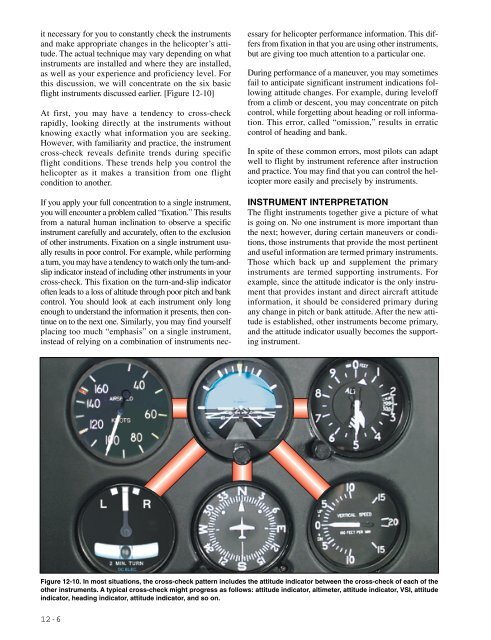Rotorcraft Flying Handbook, FAA-H-8083-21
Rotorcraft Flying Handbook, FAA-H-8083-21
Rotorcraft Flying Handbook, FAA-H-8083-21
You also want an ePaper? Increase the reach of your titles
YUMPU automatically turns print PDFs into web optimized ePapers that Google loves.
it necessary for you to constantly check the instruments<br />
and make appropriate changes in the helicopter’s attitude.<br />
The actual technique may vary depending on what<br />
instruments are installed and where they are installed,<br />
as well as your experience and proficiency level. For<br />
this discussion, we will concentrate on the six basic<br />
flight instruments discussed earlier. [Figure 12-10]<br />
At first, you may have a tendency to cross-check<br />
rapidly, looking directly at the instruments without<br />
knowing exactly what information you are seeking.<br />
However, with familiarity and practice, the instrument<br />
cross-check reveals definite trends during specific<br />
flight conditions. These trends help you control the<br />
helicopter as it makes a transition from one flight<br />
condition to another.<br />
If you apply your full concentration to a single instrument,<br />
you will encounter a problem called “fixation.” This results<br />
from a natural human inclination to observe a specific<br />
instrument carefully and accurately, often to the exclusion<br />
of other instruments. Fixation on a single instrument usually<br />
results in poor control. For example, while performing<br />
a turn, you may have a tendency to watch only the turn-andslip<br />
indicator instead of including other instruments in your<br />
cross-check. This fixation on the turn-and-slip indicator<br />
often leads to a loss of altitude through poor pitch and bank<br />
control. You should look at each instrument only long<br />
enough to understand the information it presents, then continue<br />
on to the next one. Similarly, you may find yourself<br />
placing too much “emphasis” on a single instrument,<br />
instead of relying on a combination of instruments necessary<br />
for helicopter performance information. This differs<br />
from fixation in that you are using other instruments,<br />
but are giving too much attention to a particular one.<br />
During performance of a maneuver, you may sometimes<br />
fail to anticipate significant instrument indications following<br />
attitude changes. For example, during leveloff<br />
from a climb or descent, you may concentrate on pitch<br />
control, while forgetting about heading or roll information.<br />
This error, called “omission,” results in erratic<br />
control of heading and bank.<br />
In spite of these common errors, most pilots can adapt<br />
well to flight by instrument reference after instruction<br />
and practice. You may find that you can control the helicopter<br />
more easily and precisely by instruments.<br />
INSTRUMENT INTERPRETATION<br />
The flight instruments together give a picture of what<br />
is going on. No one instrument is more important than<br />
the next; however, during certain maneuvers or conditions,<br />
those instruments that provide the most pertinent<br />
and useful information are termed primary instruments.<br />
Those which back up and supplement the primary<br />
instruments are termed supporting instruments. For<br />
example, since the attitude indicator is the only instrument<br />
that provides instant and direct aircraft attitude<br />
information, it should be considered primary during<br />
any change in pitch or bank attitude. After the new attitude<br />
is established, other instruments become primary,<br />
and the attitude indicator usually becomes the supporting<br />
instrument.<br />
Figure 12-10. In most situations, the cross-check pattern includes the attitude indicator between the cross-check of each of the<br />
other instruments. A typical cross-check might progress as follows: attitude indicator, altimeter, attitude indicator, VSI, attitude<br />
indicator, heading indicator, attitude indicator, and so on.<br />
12-6

















